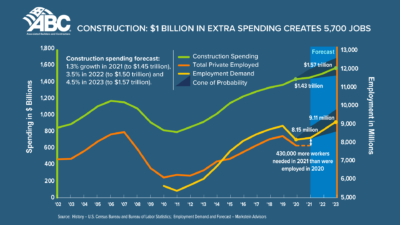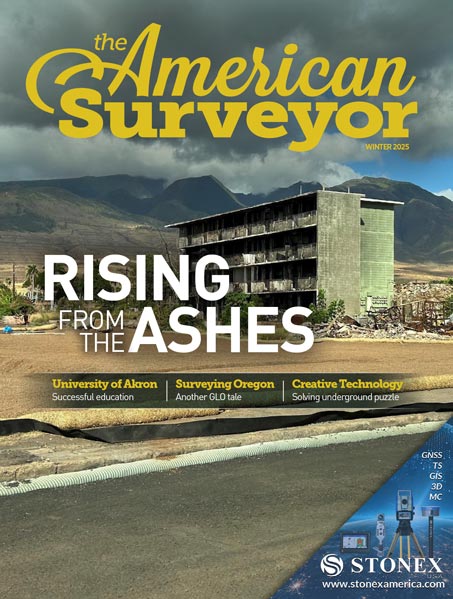 Washington, March 23—In 2021, construction companies will need to hire 430,000 more workers than they employed in 2020, according to an analysis of U.S. Bureau of Labor Statistics data released today by Associated Builders and Contractors. The analysis also revealed that every $1 billion in extra construction spending generates an average of at least 5,700 construction jobs.
Washington, March 23—In 2021, construction companies will need to hire 430,000 more workers than they employed in 2020, according to an analysis of U.S. Bureau of Labor Statistics data released today by Associated Builders and Contractors. The analysis also revealed that every $1 billion in extra construction spending generates an average of at least 5,700 construction jobs.
“According to forecasts analyzed during the COVID-19 pandemic, an impressive 430,000 more construction workers still need to be hired in 2021 to meet the demand, evidence that the construction industry is powering America’s recovery and economic engine,” said ABC President and CEO Michael Bellaman. “ABC’s annual forecast incorporates several variables that may affect the U.S. construction spend and employment demand over the next few years. These variables, which range from inflationary pressure, rising commodity costs and other global supply chain concerns to the regulatory and legislative trajectory of a new administration and the vaccine rollout domestically and even globally, are considered in the ABC cone of probability.”
“ABC and its contractor members are working tirelessly to recruit, educate and upskill our nation’s future construction workforce, putting our money where our mouth is by investing $1.5 billion annually in workforce development initiatives to equip our craft professionals with durable and transferable skill sets. Now is the time to consider a career in construction, a vocation that offers competitive wages and ample opportunities to both begin and advance in an industry that builds the places where we work, play, worship, learn and heal,” said Bellaman.
According to estimates from economic consulting firm Markstein Advisors, construction spending is likely to reach $1.45 trillion in 2021, up 1.3% from 2020. Under this scenario, employment demand increases by 430,000 this year from actual employment of 7,829,000 in 2020. A higher growth rate scenario could boost the number of additional construction workers needed in 2021 to nearly 1 million.
As of February, seasonally adjusted average hourly earnings in construction were 7.7% higher than total private average hourly earnings. For all of 2020, construction average hourly earnings were 7.8% higher than total private average hourly earnings.
Other key findings include analysis on construction spending and job creation in 2020. The spread of COVID-19 and efforts to limit its effect on the population had a substantial impact on construction activity and employment. Ironically, in 2020, nominal (not adjusted for inflation) construction spending rose by 4.8% even as employment fell by 6.3%. These factors contributed to this apparent paradox:
- A spike in building materials and labor costs, which is attributed to shortages and supply chain disruptions.
- A change in the mix of construction work, with an increase in residential construction, a segment that saw some of the largest price increases due to an uptick lumber prices.
- A reduction in labor supply encouraged builders to adopt more labor-saving technology faster than usual.
- Improvement in the scheduling and logistics of building materials delivery.
- Increased use of prefabrication and modularization.
- A decrease in the number of smaller, less efficient construction companies because they went out of business.
Click here to view the full 2021 forecast of construction spending, job creation, employment demand and more.
About ABC Resources
ABC issues news monthly news releases on construction-related economic data and trends, including on federal construction spending, employment, GDP and the Producer Price Index data, as well as state-by-state construction unemployment estimates. In addition, ABC produces the Construction Backlog Indicator, the only economic indicator that reflects the amount of work that will be performed by commercial and industrial construction contractors in the months ahead, and the Construction Confidence Index, a diffusion index that signals construction contractors’ expectations for sales, profit margins and staffing levels.
About ABC
Associated Builders and Contractors is a national construction industry trade association established in 1950 that represents more than 21,000 members. Founded on the merit shop philosophy, ABC and its 69 chapters help members develop people, win work and deliver that work safely, ethically and profitably for the betterment of the communities in which ABC and its members work. Visit us at abc.org.
